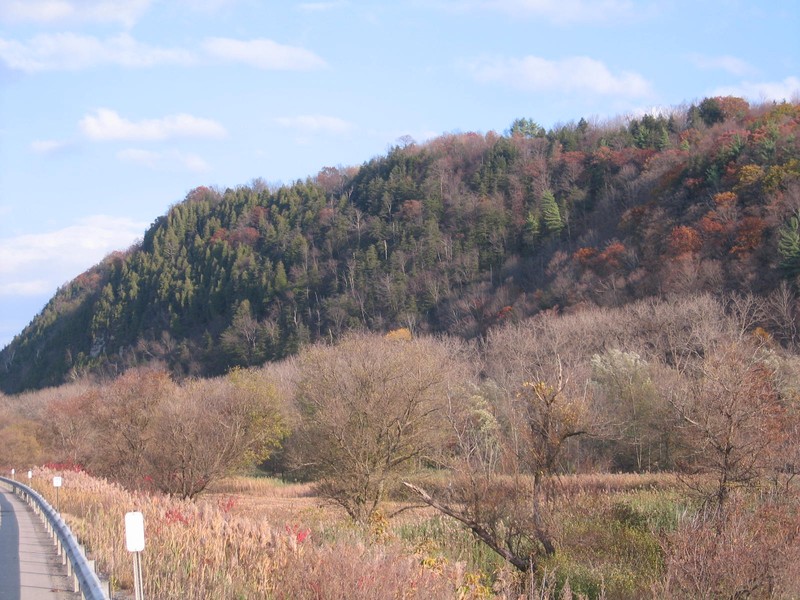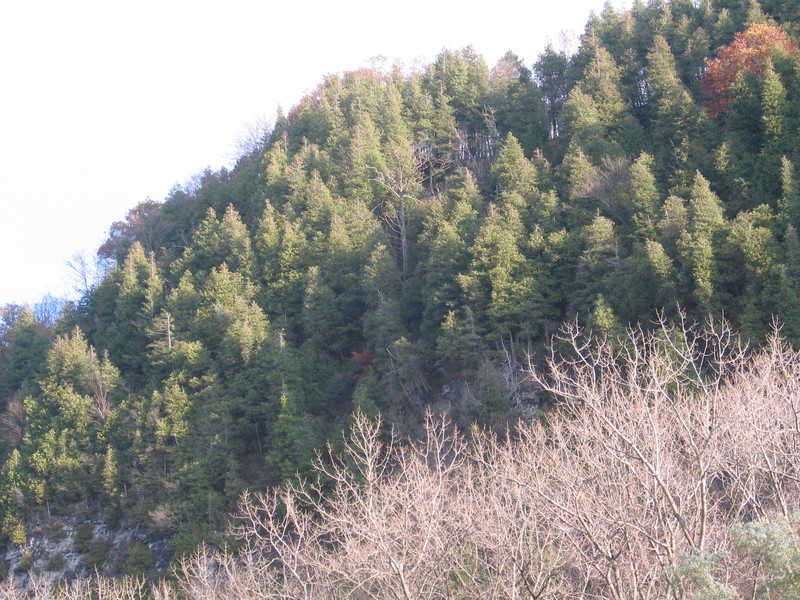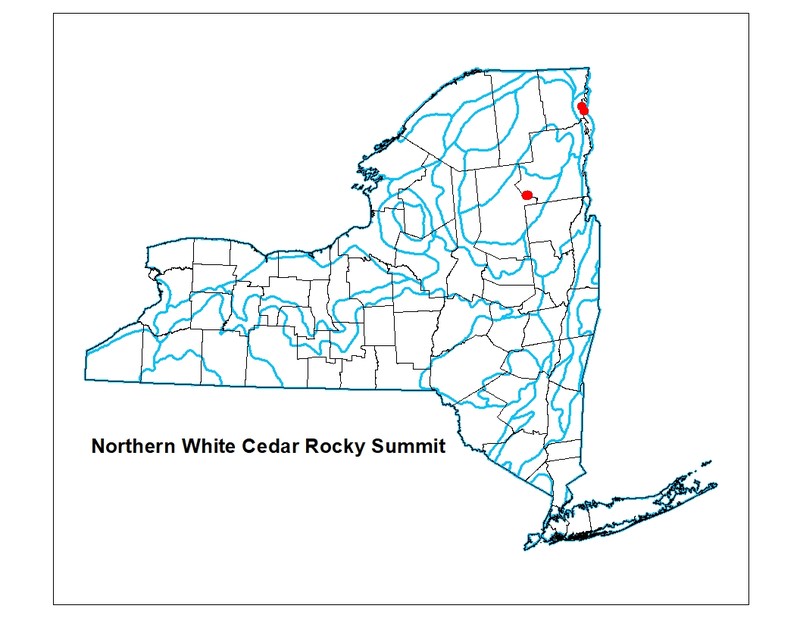Northern White Cedar Rocky Summit
- System
- Terrestrial
- Subsystem
- Barrens And Woodlands
- State Protection
- Not Listed
Not listed or protected by New York State.
- Federal Protection
- Not Listed
- State Conservation Status Rank
- S2S3
Imperiled or Vulnerable in New York - Very vulnerable, or vulnerable, to disappearing from New York, due to rarity or other factors; typically 6 to 80 populations or locations in New York, few individuals, restricted range, few remaining acres (or miles of stream), and/or recent and widespread declines. More information is needed to assign either S2 or S3.
- Global Conservation Status Rank
- G3G4
Vulnerable globally, or Apparently Secure - At moderate risk of extinction, with relatively few populations or locations in the world, few individuals, and/or restricted range; or uncommon but not rare globally; may be rare in some parts of its range; possibly some cause for long-term concern due to declines or other factors. More information is needed to assign either G3 or G4.
Summary
Did you know?
Cliff and summit communities can harbor some of the oldest trees in the state. Because these areas are inaccessible, the vegetation at these sites is often left undisturbed. In addition, the trees grow under stressful conditions, including drought, high wind, and low nutrient availability, often making them stunted, knobby, and undesirable for commercial lumber. The small size of these trees can be deceiving. Studies of the Niagara Escarpment, which extends from New York into Ontario, Canada, have found northern white cedar trees (Thuja occidentalis) that are 500 to 1000 years old.
State Ranking Justification
There are probably less than 50 occurrences statewide. Very few documented occurrences have good viability and only a few are protected on public land or private conservation land. This community has a somewhat limited statewide distribution (correlated to circumnuetral to high pH bedrock geology). Most examples are relatively small. This community has probably declined moderately from historical numbers and most occurrences are likely threatened by fire suppression.
Short-term Trends
The number and acreage of northern white cedar rocky summits in New York have probably declined slightly in recent decades due to antenna tower construction, recreational disturbances, and invasive species.
Long-term Trends
The number and acreage of northern white cedar rocky summits in New York have probably declined moderately from historical numbers as a result of fire suppression, summit clearing for development, and mining of mineral resources.
Conservation and Management
Threats
The threats to northern white cedar rocky summits are not well documented. Threats are presumed to be similar to other summit communities. In general, summit communities are threatened by development (especially plans for cellular telephone and radio towers, wind farms, and similar structures) and trampling by recreational visitors (e.g., hikers and climbers). Given the stunted and gnarly growth form of summit trees, the community is only minimally threatened for timber resources. Summits on unprotected land may targeted for mining of mineral resources. Clearing in the adjacent forest may be a threat that provides corridors for invasive plants. A few northern white cedar rocky summits are threatened by non-native plants, such as European buckthorn (Rhamnus cathartica) and Helleborine orchid (Epipactis helleborine).
Conservation Strategies and Management Practices
Management activities should include the development and implementation of prescribed burn plans at appropriate sites. Fragmenting features such as roads, abandoned tower clearings, and unnecessary trails should be reduced or minimized, and high-impact activities such as mountain biking and hang-gliding should be restricted to trails and least sensitive areas. Prevent the dumping of trash and off-trail trampling at heavily visited summits.
Development and Mitigation Considerations
Soils are very thin within and around this community, and the effect of clearing and construction on soil retention and erosion must be considered prior to any development activities. The open structure of this community is maintained by fire and presents a fire hazard to existing and proposed development. Unprotected structures located within or near this community are more susceptible to damage from fire.
Inventory Needs
Survey for occurrences statewide to advance documentation and classification of northern white cedar rocky summits, since very few occurrencs are currently documented. Continue searching for large sites in good condition (A- to AB-ranked).
Research Needs
Research is needed to determine the role of fire in maintaining this community. Plot data are needed to help clearly separate this community from similar types, such as calcareous talus slope woodland, limestone woodland, and calcareous cliff community.
Rare Species
- Blephilia ciliata (Downy Wood Mint) (guide)
- Borodinia missouriensis (Green Rock Cress) (guide)
- Bouteloua curtipendula var. curtipendula (Side Oats Grama) (guide)
- Carex scirpoidea ssp. scirpoidea (Canadian Single-spike Sedge) (guide)
- Corydalis aurea (Golden Corydalis) (guide)
- Cypripedium arietinum (Ram's Head Lady's Slipper) (guide)
- Draba arabisans (Rock Whitlow Grass) (guide)
- Draba glabella (Smooth Whitlow Grass) (guide)
- Huperzia selago (Northern Firmoss) (guide)
- Polygonum douglasii (Douglas' Knotweed) (guide)
- Sistrurus catenatus (Eastern Massasauga) (guide)
- Solidago racemosa (Riverbank Goldenrod) (guide)
- Ulmus thomasii (Rock Elm) (guide)
Range
New York State Distribution
This community is sparsely scattered in upstate New York north of the Hudson Highlands, where bedrock is calcareous. It is thought to be more common in the northern part of this range, and possibly limited to the Northern Appalachians and Great Lakes Ecoregions.
Global Distribution
This community is possibly limited to the Northeast U.S. and Great Lakes basin. This range is estimated to span north to Ontario, west to Minnesota, south to Central Michigan and Central New York, and east to New Brunswick.
Best Places to See
- Hudson River Gorge
- Little Nose (Montgomery County)
- Valcour Island
Identification Comments
General Description
A community that occurs on cool, dry, rocky ridgetops and summits where the bedrock is calcareous (such as limestone or dolomite), and the soils are more or less calcareous. The vegetation may be sparse or patchy, with numerous rock outcrops. The species have predominantly boreal distributions. This community is often surrounded by other calcareous communities, such as limestone woodland, calcareous talus slope woodland, and calcareous cliff community. Northern white cedar (Thuja occidentalis) is a characteristic tree.
Characters Most Useful for Identification
Characteristic species include northern white cedar (Thuja occidentalis), American basswood (Tilia americana), and hop hornbeam (Ostrya virginiana). Other trees at low percent cover include sugar maple (Acer saccharum), American beech (Fagus grandifolia), and red pine (Pinus resinosa). Characteristic herbs include upland white aster (Oligoneuron album), bristleleaf sedge (Carex eburnea), wild columbine (Aquilegia canadensis), bulblet fern (Cystopteris bulbifera), and oatgrass (Trisetum triflorum).
Elevation Range
Known examples of this community have been found at elevations between 130 feet and 1,575 feet.
Best Time to See
Since northern white cedar (Thuja occidentalis) is an evergreen tree and dominant in this community, its beauty can enjoyed year round. The northern white cedar rocky summit on the slopes of Little Nose east of Canajoharie can be seen year round while travelling on the NYS Thruway.
Northern White Cedar Rocky Summit Images
Classification
International Vegetation Classification Associations
This New York natural community encompasses all or part of the concept of the following International Vegetation Classification (IVC) natural community associations. These are often described at finer resolution than New York's natural communities. The IVC is developed and maintained by NatureServe.
- Northern White-cedar / Black Huckleberry - Lowbush Blueberry Woodland (CEGL006411)
- Northern White-cedar Limestone Cliff (CEGL002451)
NatureServe Ecological Systems
This New York natural community falls into the following ecological system(s). Ecological systems are often described at a coarser resolution than New York's natural communities and tend to represent clusters of associations found in similar environments. The ecological systems project is developed and maintained by NatureServe.
- Central Interior Calcareous Cliff and Talus (CES202.690)
- Laurentian-Acadian Calcareous Cliff and Talus (CES201.570)
- Laurentian-Acadian Calcareous Rocky Outcrop (CES201.572)
Characteristic Species
-
Trees > 5m
- Acer saccharum (sugar maple)
- Betula alleghaniensis (yellow birch)
- Fraxinus americana (white ash)
- Ostrya virginiana (hop hornbeam, ironwood)
- Thuja occidentalis (northern white cedar, arbor vitae)
- Tilia americana var. americana (American basswood)
-
Shrubs 2 - 5m
- Shepherdia canadensis (Canada buffalo-berry)
-
Tree saplings
- Abies balsamea (balsam fir)
- Fagus grandifolia (American beech)
- Picea rubens (red spruce)
- Populus tremuloides (trembling aspen, quaking aspen)
- Thuja occidentalis (northern white cedar, arbor vitae)
-
Herbs
- Antennaria neglecta (field pussy-toes)
- Aquilegia canadensis (wild columbine, red columbine)
- Carex blanda (eastern woodland sedge)
- Carex eburnea (bristle-leaved sedge)
- Cystopteris bulbifera (bulblet fern)
- Cystopteris fragilis (fragile fern)
- Dryopteris marginalis (marginal wood fern)
- Epipactis helleborine (helleborine, weed orchid)
- Huperzia lucidula (shining firmoss)
- Poa compressa (flat-stemmed blue grass, Canada blue grass)
- Thalictrum dioicum (early meadow-rue)
-
Nonvascular plants
- Anomodon attenuatus
- Cladina sp.
- Cladonia sp.
- Fissidens
- Thuidium delicatulum
Similar Ecological Communities
- Calcareous cliff community
(guide)
Northern white cedar rocky summits and calcareous cliff communities can occur together in the landscape on the same calcareous or circumneutral bedrock outcrop. Northern white cedar (Thuja occidentalis) may be dominant in both communities. However, calcareous cliff communities are steeper (>45 degrees slope to vertical) and the vegetation is usually sparse (<10% cover), whereas northern white cedar rocky summits are less steep (<45 degrees slope) and the vegetation is more patchy (>25% cover).
- Calcareous talus slope woodland
(guide)
While both communities may occur on calcareous or circumneutral rock, northern white cedar rocky summits occur on stable consolidated rock outcrops, usually along ridges and summits, while calcareous talus slope woodlands occur on more unstable talus (loose rock) slopes. Trees are often stunted and contorted in summit communities. Talus communities are often located at the base of cliffs, while summit communities are usually adjacent to, or on top of, cliff communities.
- Red cedar rocky summit
(guide)
While both communities may occur on calcareous or circumneutral bedrock, red cedar rocky summits are dominated by eastern red cedar (Juniperus virginiana), while northern white cedar rocky summits are dominated by northern white cedar (Thuja occidentalis).
- Spruce-fir rocky summit
(guide)
Unlike spruce-fir rocky summits, northern white cedar rocky summit communities occur on calcareous rocky outcrops, such as limestone and dolomite. The canopy is dominated by northern white cedar (Thuja occidentalis), American basswood (Tilia americana), and eastern hop hornbeam (Ostrya virginiana). Spruce-fir rocky summit is a boreal high elevation community of cooler sites, dominated by spruce and fir.
Vegetation
Percent cover
This figure helps visualize the structure and "look" or "feel" of a typical Northern White Cedar Rocky Summit. Each bar represents the amount of "coverage" for all the species growing at that height. Because layers overlap (shrubs may grow under trees, for example), the shaded regions can add up to more than 100%.
Additional Resources
References
Edinger, G. J., D. J. Evans, S. Gebauer, T. G. Howard, D. M. Hunt, and A. M. Olivero (editors). 2014. Ecological Communities of New York State. Second Edition. A revised and expanded edition of Carol Reschke’s Ecological Communities of New York State. New York Natural Heritage Program, New York State Department of Environmental Conservation, Albany, NY. https://www.nynhp.org/ecological-communities/
Edinger, Gregory J., D.J. Evans, Shane Gebauer, Timothy G. Howard, David M. Hunt, and Adele M. Olivero (editors). 2002. Ecological Communities of New York State. Second Edition. A revised and expanded edition of Carol Reschke's Ecological Communities of New York State. (Draft for review). New York Natural Heritage Program, New York State Department of Environmental Conservation. Albany, NY. 136 pp.
Larson, D.W. 1989. Effects of disturbance on old-growth Thuja occidentalis at cliff edges. Can. J. Bot. 68:1147-155.
Larson, D.W., U. Matthes, and P.E. Kelly. 2000. Cliff Ecology: Pattern and Process in Cliff Ecosystems. Cambridge University Press, New York, New York.
New York Natural Heritage Program. 2024. New York Natural Heritage Program Databases. Albany, NY.
Reschke, Carol. 1990. Ecological communities of New York State. New York Natural Heritage Program, New York State Department of Environmental Conservation. Latham, NY. 96 pp. plus xi.
Sorenson, E. and R. Popp. Limestone bluff cedar-pine forests of Vermont: A statewide inventory. Nongame and Natural Heritage Program, Vermont Fish and Wildlife Department, Agency of Natural Resources, Waterbury, Vermont.
Links
About This Guide
This guide was authored by: Gregory J. Edinger
Information for this guide was last updated on: March 26, 2024
Please cite this page as:
New York Natural Heritage Program. 2024.
Online Conservation Guide for
Northern white cedar rocky summit.
Available from: https://guides.nynhp.org/northern-white-cedar-rocky-summit/.
Accessed July 27, 2024.



